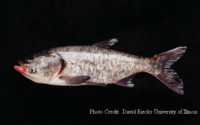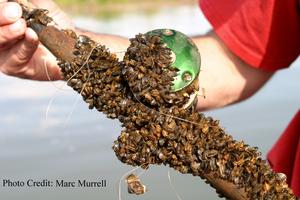UMKC Environmental Science students created this video as part of a project for their required course: Issues in Environmental Science. Our thanks to Kim Gasperi, Allen Wolff, Karen Lavendusky and Kimberly Ballard.
Important Invasive Species on the River
Asian Carp
Asian carp are an invasive species that can be costly and even dangerous to those who boating on the river. The aquatic nuisance group of Asian carp consists of three species. Common names for these three species are the Bighead carp,(see below) the Silver carp, and the Black carp(also below). Asian carp are a problem because they directly compete with native fish for food resources and grow quickly, consuming 40 percent of their body weight every day. Black carp are particularly detrimental to native snails and mussels, as they feed exclusively on them. Silver carp, distinctively pose a threat to boaters as they will leap out of the water when disturbed by boat motors and can cause injury. As reported by KDWPT, Asian carp have been reported in increased populations below Bowersock Dam in Lawrence, and below Water One’s weir in Johnson County. Asian carp can now be found in the Kansas River and in any stream that connects to the Kansas river.
Zebra Mussels
These mussels produce free-floating microscopic larvae, which enable aquatic users to unknowingly transport them between water bodies and allows them to easily infest facilities through surface water intakes. Zebra mussels were first confirmed in the state in 2003 in El Dorado Reservoir in the Walnut River Basin in south central Kansas. Since that time, Zebra mussels have spread to nine other Kansas lakes. Once introduced, new populations of Zebra mussels expand quickly. Zebra mussels have been confirmed by various municipalities and industries along the Kansas River.
What can you do?
- Clean, drain, and dry your boat when moving between water bodies.
- Don’t Move Live Fish.
- Get Bait from Certified Bait Dealers.
- Know the Laws and Regulations.
- Report an Aquatic Nuisance Species
- Be a Responsible Aquarium Owner.
For more information:
Visit the Kansas Department of Wildlife, Parks and Tourism Aquatic Nuisance Species website for more information.
Information on this page is courtesy of the Kansas Water Office, and the Kansas Department of Wildlife Parks and Tourism.
For more information on what you can do to help prevent the spread of Asian Carp go to the Aquatic Nuisance Species Control website



